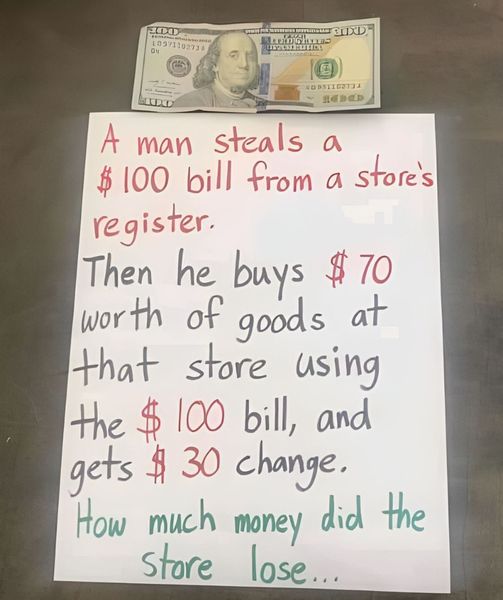In today’s digital age, content spreads faster than ever before. From memes to viral challenges, the internet is a breeding ground for discussions, debates, and sometimes, a bit of confusion. Recently, a simple yet perplexing math brain teaser known as the $100 puzzle has taken social media by storm, leaving millions scratching their heads. If you’re wondering why this puzzle has everyone so riled up, you’re in the right place.

What is the $100 Brain Teaser?
At the heart of this viral sensation is a seemingly straightforward scenario. The puzzle, originally shared on X (formerly known as Twitter) by the account Out of Context Human Race, poses the following challenge:
A man steals a $100 bill from a store’s cash register. He then uses that same $100 bill to buy $70 worth of goods, and receives $30 in change. The question is: How much money did the store lose?
The Immediate Responses: A Divided Internet
As the brain teaser spread across social media, it sparked an intense debate among users. The comments section was flooded with various interpretations and calculations, each confidently asserting the correct answer.
The $100 Loss Theory
Some users quickly concluded that the store’s loss was straightforward: $100. They reasoned that since the thief stole $100 from the register, that amount was the total loss, regardless of subsequent transactions.
The $130 Loss Argument
Others took a different approach, arguing that the store lost $130 in total. This calculation includes the $100 stolen and the additional $30 given as change during the thief’s purchase.
The Profit Margin Perspective
A few commenters suggested that the real loss could depend on the profit margins of the goods sold. According to this view, the store might not have lost the full $70 worth of goods if the cost price was lower than the selling price.
Breaking Down the Puzzle: What’s the Real Answer?
Now that we’ve seen the range of responses, let’s break down the scenario and uncover the truth.
Step 1: The Initial Theft
The first part of the puzzle is clear: the thief steals $100 from the store’s register. At this point, the store is down $100.
Step 2: The Purchase
Next, the thief uses the stolen $100 bill to buy $70 worth of merchandise. On the surface, it may seem like the store has recovered the stolen money, but there’s a catch. The store now hands the thief $30 in change, which means the store is now down $30 in cash.
Step 3: The Cost of Goods
In addition to the $30 in lost cash, the store has also lost the $70 worth of goods the thief purchased. This is an important detail that many overlook.
The Final Calculation
When you add the $30 in lost cash to the $70 worth of goods, the total loss for the store is indeed $100. The key to solving this puzzle is understanding that the store didn’t just lose the stolen money—it also lost the value of the goods sold.
Why Did This Puzzle Go Viral?
So, what makes this brain teaser so compelling? There are a few reasons why it captured the internet’s attention and sparked widespread discussion.
It Challenges Intuition
The $100 puzzle is a classic example of a problem that seems simple but challenges our intuitive thinking. It forces us to look beyond the obvious and consider the underlying details.
It Encourages Critical Thinking
This puzzle isn’t just about math—it’s about logic and reasoning. It encourages us to think critically, analyze the situation from different angles, and avoid jumping to conclusions.
It’s Easy to Share and Discuss
With its straightforward premise, the puzzle is easy to share on social media, making it the perfect candidate for viral content. The debate it sparked also fueled its popularity, as people eagerly discussed and defended their answers.
The Broader Impact of Viral Content
This brain teaser is just one example of how viral content can capture the public’s imagination. In an age where information spreads at lightning speed, puzzles and challenges like this one can unite (or divide) internet users around the world.
The Power of Puzzles in the Digital Age
Puzzles have always been popular, but the internet has amplified their reach and impact. They stimulate our brains, provide entertainment, and often spark lively debates. Whether it’s a simple math problem or a complex riddle, puzzles tap into our innate desire to solve problems and prove our intellectual prowess.
The Role of Social Media in Amplifying Content
Social media platforms like X (formerly Twitter) play a crucial role in amplifying content. They allow ideas, challenges, and debates to spread quickly, turning a simple brain teaser into a global phenomenon.
Conclusion: Embrace the Challenge
The $100 brain teaser is more than just a puzzle—it’s a reminder of the importance of critical thinking and the power of the internet to connect us through shared experiences. As you navigate the digital landscape, take the time to engage with challenges like these. They’re not only fun but also an excellent way to sharpen your mind and see the world from new perspectives.
So, the next time you encounter a brain teaser that stumps you, don’t be discouraged. Embrace the challenge, analyze the details, and enjoy the thrill of solving the puzzle. Who knows, you might just be the one to crack the next viral conundrum that takes the internet by storm!





